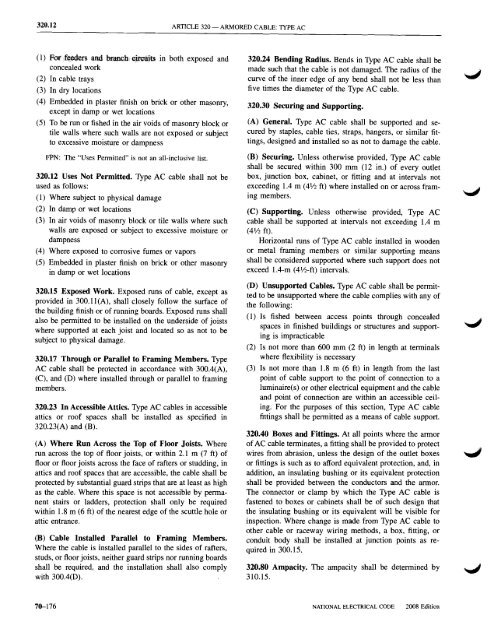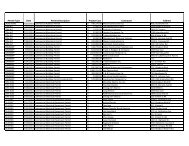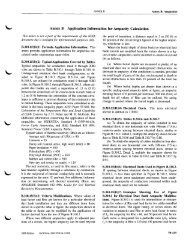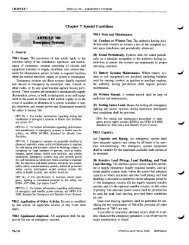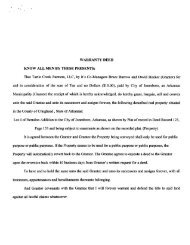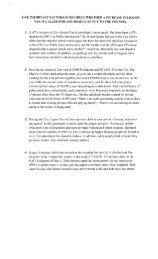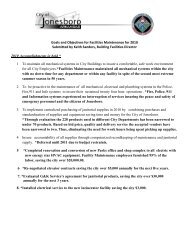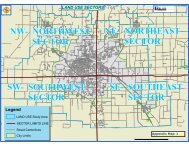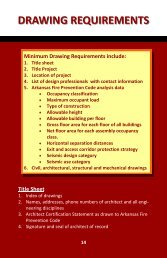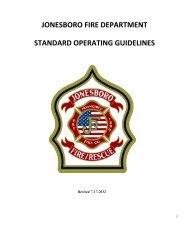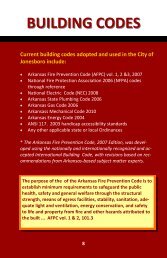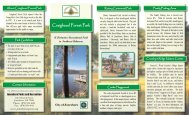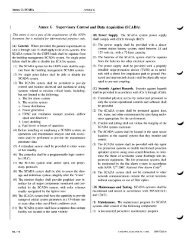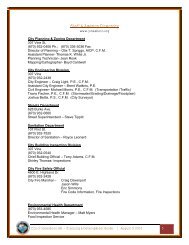Chapter 3 Wiring Methods and Materials
Chapter 3 Wiring Methods and Materials
Chapter 3 Wiring Methods and Materials
Create successful ePaper yourself
Turn your PDF publications into a flip-book with our unique Google optimized e-Paper software.
320.12 ARTICLE 320 - ARMORED CABLE: lYPE AC<br />
(I) Forf~¢t:J~rs <strong>and</strong> btaOGh ~lteQits in both exposed <strong>and</strong><br />
concealed work<br />
(2) In cable trays<br />
(3) In dry locations<br />
(4) Embedded in plaster finish on brick or other masonry,<br />
except in damp or wet locations<br />
(5) To be run or fished in the air voids of masonry block or<br />
tile walls where such walls are not exposed or subject<br />
to excessive moisture or dampness<br />
FPN: The "Uses Permitted" is not an all-inclusive list.<br />
320.12 Uses Not Permitted. Type AC cable shall not be<br />
used as follows:<br />
(1) Where subject to physical damage<br />
(2) In damp or wet locations<br />
(3) In air voids of masonry block or tile walls where such<br />
walls are exposed or subject to excessive moisture or<br />
dampness<br />
(4) Where exposed to corrosive fumes or vapors<br />
(5) Embedded in plaster finish on brick or other masonry<br />
in damp or wet locations<br />
320.15 Exposed Work. Exposed runs of cable, except as<br />
provided in 300.11 (A), shall closely follow the surface of<br />
the building finish or of running boards. Exposed runs shall<br />
also be permitted to be installed on the underside of joists<br />
where supported at each joist <strong>and</strong> located so as not to be<br />
subject to physical damage.<br />
320.17 Through or Parallel to Framing Members. Type<br />
AC cable shall be protected in accordance with 300.4(A),<br />
(C), <strong>and</strong> (D) where installed through or parallel to framing<br />
members.<br />
320.23 In Accessible Attics. Type AC cables in accessible<br />
attics or roof spaces shall be installed as specified in<br />
320.23(A) <strong>and</strong> (B).<br />
(A) Where Run Across the Top of Floor Joists. Where<br />
run across the top of floor joists, or within 2.1 m (7 ft) of<br />
floor or floor joists across the face of rafters or studding, in<br />
attics <strong>and</strong> roof spaces that are accessible, the cable shall be<br />
protected by substantial guard strips that are at least as high<br />
as the cable. Where this space is not accessible by permanent<br />
stairs or ladders, protection shall only be required<br />
within 1.8 m (6 ft) of the nearest edge of the scuttle hole or<br />
attic entrance.<br />
(B) Cable Installed Parallel to Framing Members.<br />
Where the cable is installed parallel to the sides of rafters,<br />
studs, or floor joists, neither guard strips nor running boards<br />
shall be required, <strong>and</strong> the installation shall also comply<br />
with 300.4(D).<br />
320.24 Bending Radius. Bends in Type AC cable shall be<br />
made such that the cable is not damaged. The radius of the<br />
curve of the inner edge of any bend shall not be less than<br />
five times the diameter of the Type AC cable.<br />
320.30 Securing <strong>and</strong> Supporting.<br />
(A) General. Type AC cable shall be supported <strong>and</strong> secured<br />
by staples, cable ties, straps, hangers, or similar fittings,<br />
designed <strong>and</strong> installed so as not to damage the cable.<br />
(B) Securing. Unless otherwise provided, Type AC cable<br />
shall be secured within 300 mm (12 in.) of every outlet<br />
box, junction box, cabinet, or fitting <strong>and</strong> at intervals not<br />
exceeding 1.4 m (4Vz ft) where installed on or across framing<br />
members.<br />
(C) Supporting. Unless otherwise provided, Type AC<br />
cable shall be supported at intervals not exceeding 1.4 m<br />
(4Vz ft).<br />
Horizontal runs of Type AC cable installed in wooden<br />
or metal framing members or similar supporting means<br />
shall be considered supported where such support does not<br />
exceed 1.4-m (4Vz-ft) intervals.<br />
(D) Unsupported Cables. Type AC cable shall be permitted<br />
to be unsupported where the cable complies with any of<br />
the following:<br />
(1) Is fished between access points through concealed<br />
spaces in finished buildings or structures <strong>and</strong> supporting<br />
is impracticable<br />
(2) Is not more than 600 mID (2 ft) in length at terminals<br />
where flexibility is necessary<br />
(3) Is not more than 1.8 m (6 ft) in length from the last<br />
point of cable support to the point of connection to a<br />
luminaire(s) or other electrical equipment <strong>and</strong> the cable<br />
<strong>and</strong> point of connection are within an accessible ceiling.<br />
For the purposes of this section, Type AC cable<br />
fittings shall be permitted as a means of cable support.<br />
320.40 Boxes <strong>and</strong> Fittings. At all points where the armor<br />
ofAC cable terminates, a fitting shall be provided to protect<br />
wires from abrasion, unless the design of the outlet boxes<br />
or fittings is such as to afford equivalent protection, <strong>and</strong>, in<br />
addition, an insulating bushing or its equivalent protection<br />
shall be provided between the conductors <strong>and</strong> the armor.<br />
The connector or clamp by which the Type AC cable is<br />
fastened to boxes or cabinets shall be of such design that<br />
the insulating bushing or its equivalent will be visible for<br />
inspection. Where change is made from Type AC cable to<br />
other cable or raceway wiring methods, a box, fitting, or<br />
conduit body shall be installed at junction points as required<br />
in 300.15.<br />
320.80 Ampacity. The ampacity shall be determined by<br />
310.15.<br />
70-176<br />
NATIONAL ELECTRICAL CODE<br />
2008 Edition


